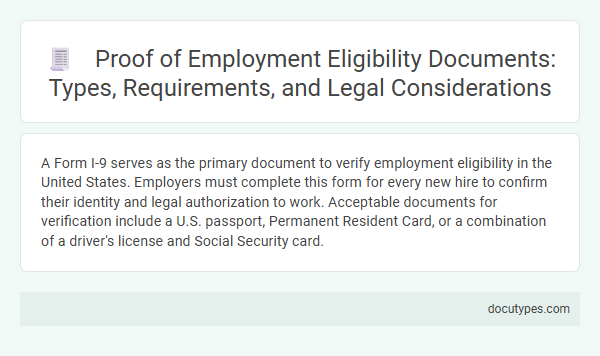A Form I-9 serves as the primary document to verify employment eligibility in the United States. Employers must complete this form for every new hire to confirm their identity and legal authorization to work. Acceptable documents for verification include a U.S. passport, Permanent Resident Card, or a combination of a driver's license and Social Security card.
Introduction to Proof of Employment Eligibility
Proof of employment eligibility is a crucial requirement when starting a new job. It demonstrates your legal authorization to work within a specific country.
- Form I-9 - This federal form is used in the United States to verify an employee's identity and employment authorization.
- Work Visa - A document issued by government authorities allowing foreign nationals to work legally in the country.
- Social Security Card - Often used as evidence of work eligibility by confirming the holder's Social Security number and citizenship or lawful status.
Key Types of Employment Eligibility Documents
The most common proof of employment eligibility is the Form I-9, which requires employees to provide documentation verifying their identity and work authorization. Key types of employment eligibility documents include a U.S. passport, Permanent Resident Card (Green Card), and Employment Authorization Document (EAD). Additionally, other acceptable documents include a driver's license combined with a Social Security card and a birth certificate issued by a U.S. state or territory.
Requirements for Verifying Employment Eligibility
Proof of employment eligibility is typically verified through specific government-issued documents. These documents confirm an individual's legal right to work in the country.
Key requirements for verifying employment eligibility include presenting an acceptable form of identification, such as a U.S. passport or a Permanent Resident Card. Employers must review original documents like a Social Security card or a driver's license alongside a birth certificate or employment authorization document. Ensuring these documents are valid and unexpired is essential to satisfy federal employment verification laws.
Acceptable Documents for U.S. Citizens
Proof of employment eligibility for U.S. citizens is established through specific documents approved by the U.S. Citizenship and Immigration Services (USCIS). The Form I-9 requires employees to present acceptable evidence verifying both identity and employment authorization.
Acceptable documents for U.S. citizens include a U.S. passport, a birth certificate combined with a government-issued photo ID, or a Certificate of Naturalization. Your employer may also accept a Social Security card alongside a driver's license or state ID as proof of eligibility to work in the United States.
Acceptable Documents for Non-U.S. Citizens
Proof of employment eligibility for non-U.S. citizens often requires specific documents that verify their legal right to work. Acceptable documents include a Permanent Resident Card (Green Card) or an Employment Authorization Document (EAD).
Other acceptable options are foreign passports with Form I-94 or Form I-94A showing authorized employment, or a combination of documents such as a foreign passport and Form I-766. Your employer must ensure these documents are current and valid to confirm employment eligibility.
Completing Form I-9: Step-by-Step Guide
| Document Purpose | Proof of Employment Eligibility in the United States |
|---|---|
| Key Form | Form I-9, Employment Eligibility Verification |
| Responsible Party | Employer and Employee |
| Step 1: Employee Completes Section 1 | Provide personal information, including full name, address, date of birth, and attest to citizenship or immigration status. |
| Step 2: Employer Reviews Documents | Examine original documents that establish identity and employment authorization as specified by the U.S. Citizenship and Immigration Services (USCIS). |
| Step 3: Employer Completes Section 2 | Record document information, date of employment, and certify eligibility within three business days of hire. |
| Acceptable Documents | Passport, Permanent Resident Card (Green Card), Driver's License with Social Security Card, Employment Authorization Document (EAD), among others listed on the I-9 form Lists A, B, and C. |
| Retention Requirements | Employers must retain Form I-9 for the duration of employment plus three years after termination. |
| Compliance Consequences | Failure to complete Form I-9 correctly can result in penalties, fines, and legal consequences for the employer. |
Legal Obligations for Employers
What document serves as proof of employment eligibility? The Employment Authorization Document (EAD) and Form I-9 are essential for verifying a worker's legal right to work in the United States. Employers are legally obligated to review these documents to ensure compliance with immigration laws.
Common Mistakes and How to Avoid Them
The primary document that serves as proof of employment eligibility in the United States is the Form I-9, which requires acceptable identification and work authorization documents. Common mistakes include submitting expired documents, providing inconsistent information, and failing to complete the form within the required timeframe. To avoid errors, employees should review the list of acceptable documents carefully and employers must verify authenticity and maintain timely compliance with U.S. Citizenship and Immigration Services (USCIS) regulations.
Penalties for Non-Compliance
The document that serves as proof of employment eligibility is the I-9 form, which verifies your identity and authorization to work in the United States. Employers must complete and retain this form for all employees to comply with federal law.
- Fines for Employers - Employers may face civil penalties ranging from $250 to $2,500 for each unauthorized employee.
- Criminal Charges - Knowing hiring or continued employment of unauthorized workers can lead to criminal prosecution and higher fines.
- Record-Keeping Violations - Failure to properly complete, retain, or present I-9 forms can result in additional penalties and enforcement actions.
Your adherence to employment eligibility documentation protects against legal consequences and ensures compliance with immigration laws.
What Document Serves as Proof of Employment Eligibility? Infographic

